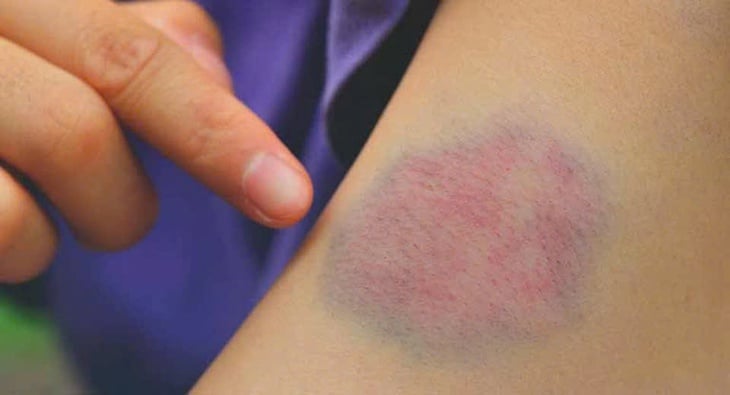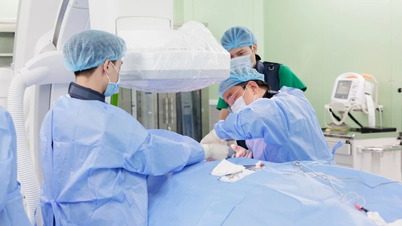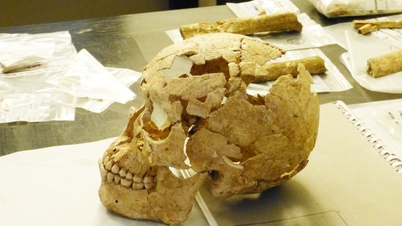
Unexplained bruises on the skin can be a sign of platelet disorder - Photo: BVCC
Bruising can be a sign of a platelet disorder.
According to Dr. Pham Lien Huong - Center for Hematology and Blood Transfusion, Bach Mai Hospital - platelets are small, non-nucleated cells, born from bone marrow, responsible for maintaining the integrity of blood vessels and participating in the blood clotting process.
Each platelet only lives for about 7-10 days, but their role is extremely important. When a blood vessel is damaged, platelets are the first force to reach the "scene", adhere to the site of the tear, activate and clump together to form an initial "plug".
At the same time, the platelet surface also activates the coagulation cascade, helping to form a stable blood clot, stop bleeding and support wound healing.
When the number or function of platelets decreases, this hemostasis mechanism is disrupted. As a result, the body is prone to bleeding, sometimes with only the slightest impact, even without a clear cause.
The warning signs of platelet disorders can be quite varied, but the most common is easy bruising. Bruises can appear spontaneously, are blue-purple in color, vary in size, and are often found on the hands and feet.
Some people also notice tiny red spots on their skin – called petechiae – especially on the lower legs or inner arms. As the bleeding spreads, it can form a purpura or large bruise.
In addition, the patient may have frequent nosebleeds, bleeding gums when brushing teeth, prolonged bleeding after minor injuries, or abnormally prolonged menstrual periods in women.
In severe cases, there may be blood in the urine, black stools (gastrointestinal bleeding), or even brain or internal bleeding, which is life-threatening.
"Not all bruises are caused by platelet disorders, but if you see this condition appearing frequently, without a clear cause, or accompanied by other signs of bleeding, you should see a hematologist," said Dr. Huong.
Causes of platelet disorders
Regarding the causes of platelet disorders, Dr. Huong explained that they can be divided into two main groups: one is due to bone marrow reducing platelet production, the other is due to platelet destruction or excessive consumption in the blood.
Bone marrow can be weakened by malignant diseases such as leukemia, by viral infections such as dengue fever, HIV, hepatitis; vitamin B12 and folic acid deficiency; chemotherapy, radiotherapy, or by alcohol abuse.
In the second group, the common condition is immune thrombocytopenic purpura, when the body creates antibodies that destroy platelets. Certain medications, severe infections, autoimmune diseases such as lupus, or an abnormally enlarged spleen can also be the culprit.
In addition, there are people who have normal platelet counts but impaired function - either congenitally or due to taking medications such as aspirin, clopidogrel, NSAIDs, or chronic kidney disease.
To accurately determine this condition, doctors often order a blood test to measure platelet count.
If abnormalities are suspected, the patient may undergo additional specialized tests such as blood smears, coagulation tests, antibody tests, and even bone marrow biopsy if necessary.
Treatment of platelet disorders depends on the cause and severity of the disease.
If mild, monitoring may be sufficient. If vitamin deficiency is present, supplementation will be given. If medication is present, the medication should be discontinued. In severe cases or those with immune thrombocytopenic purpura, the doctor may prescribe immunosuppressants, intravenous globulin, or splenectomy. Platelet transfusions are only performed when there is a risk of severe bleeding.
"Although platelets are small, they play a vital role in the body's defense mechanism against blood loss. So don't be subjective if you find yourself bruising easily or experiencing signs of abnormal bleeding," Dr. Huong warned.
Source: https://tuoitre.vn/bong-dung-xuat-hien-vet-bam-tim-co-the-la-dau-hieu-roi-loan-tieu-cau-20250606203524057.htm


![[Photo] The 5th Patriotic Emulation Congress of the Central Inspection Commission](https://vphoto.vietnam.vn/thumb/1200x675/vietnam/resource/IMAGE/2025/10/27/1761566862838_ndo_br_1-1858-jpg.webp)

![[Photo] National Assembly Chairman Tran Thanh Man receives Chairman of the House of Representatives of Uzbekistan Nuriddin Ismoilov](https://vphoto.vietnam.vn/thumb/1200x675/vietnam/resource/IMAGE/2025/10/27/1761542647910_bnd-2610-jpg.webp)
![[Photo] Party Committees of Central Party agencies summarize the implementation of Resolution No. 18-NQ/TW and the direction of the Party Congress](https://vphoto.vietnam.vn/thumb/1200x675/vietnam/resource/IMAGE/2025/10/27/1761545645968_ndo_br_1-jpg.webp)
































































































Comment (0)